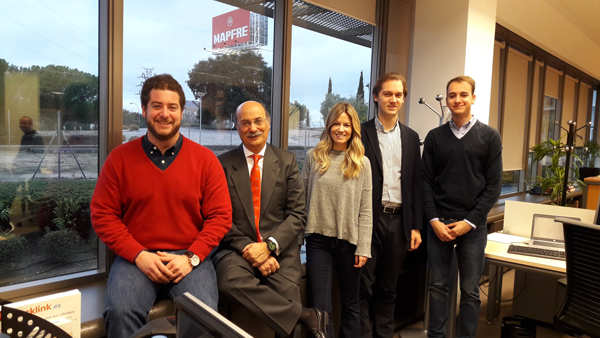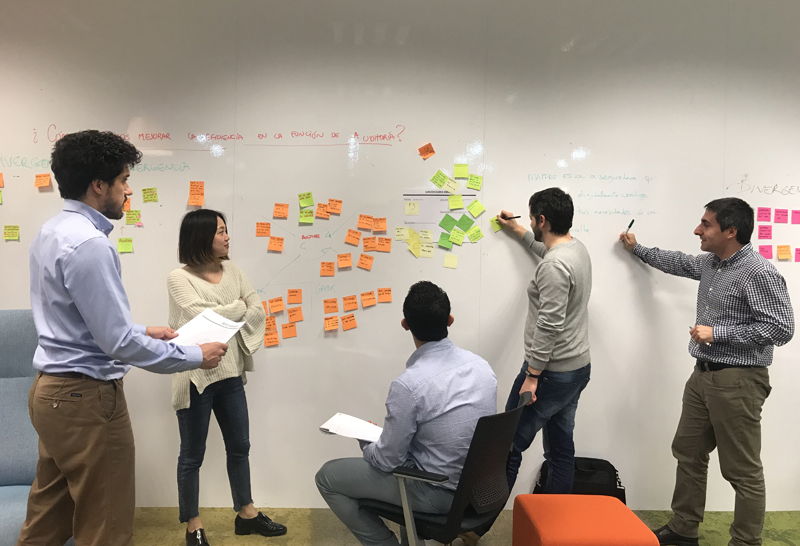Data management and analysis, standardization of processes, optimizing operating costs… All the objectives pursued by our actions in the digital marketing field are aligned with the overall strategy of the MAPFRE Group, and are duly regulated as outlined in our Corporate Digital Marketing Policy. The ultimate goal is to connect all our digital channels so as to achieve the most comprehensive view possible of our clients, maximum efficiency and the best market opportunities.
TEXT MARÍA JESÚS PÉREZ FUENTES | ILLUSTRATION THINKSTOCK
Nobody still doubts that the Internet has significantly changed our consumption habits and behavior. Users have embraced the online world as their first option for getting information about products or services, comparing and – ever increasingly – acquiring them. For years, in the 1.0 world, companies used a commercial website as the sole showcase for displaying their product portfolio and attracting customers. However, nowadays, we have moved on to a more complex scenario in which consumers have new needs, but there are also new techniques and applications that enable them to be satisfied.
This digital revolution has affected the way in which companies perform their marketing activities. In just a few years, this area has evolved significantly within companies, in line with the development of the new digital technologies and society itself, undergoing a permanent process of adaptation to the ever-changing digital world. It is therefore necessary to adapt ourselves to meet the specific needs of so-called digital clients, with their increasing demands for more streamlined processes and greater quality of service when it comes to purchasing a product.
In this new reality, digital marketing — taken here to refer to all the activities the MAPFRE Group carries out using the Internet and digital technologies — is key to our business strategy, given the solutions it provides to help tackle new business challenges. MAPFRE’s current activity in this area is governed by the Corporate Digital Marketing Policy, approved by the Executive Committee in September 2017.
This policy outlines the Group’s objectives as regards marketing via digital channels, such as optimizing the costs of acquisition, monitoring and analysis, data management, or the standardization and control of all processes. This document is applicable to the techniques for the creation and execution of activities related to digital marketing in all of MAPFRE’s business units and corporate areas.

The unit responsible for defining and updating the contents of this policy, in accordance with the Group’s needs and market opportunities, is the Corporate Digital Division, which forms part of the Corporate Business Support Area. The Digital Marketing Area, in turn, is integrated within this division. In addition, the division helps with the dissemination and implementation of common methodologies that serve as a reference on this matter throughout the Group. The full engagement of each of MAPFRE’s business areas and units facilitates full knowledge and application of this policy in their local area, making use of the measurement models and optimizing the results of the online sales actions, in order to increase their efficacy.
Moreover, our Corporate Policy envisages tools that ensure the progress of the digital marketing activities is measured, compared and improved, in keeping with the specificities of each market and the maturity levels of the digital business in each company. The employee training programs are an essential part of this process. They are defined in collaboration with the Corporate Human Resources Area and are essential for furthering the exchange of knowledge and best practices, as well as creating communities and discussion forums. The processes governed by the Policy include the standardization of contracts, and selection and management models for service providers and agencies. These facilitate the task of analyzing, managing and organizing all the different types of digital marketing activities within MAPFRE.
The ultimate goal is to seek maximum efficiency, and optimal adaptation to our digital clients and market opportunities, through the design of effective digital actions and campaigns targeting the most demanding consumers. It is here that the segmentation process comes into play. The most recent digital marketing techniques are geared toward big data management for the profiling of both current and potential clients. It is our Business and Technical teams that define the products designed for each segment.

The important thing is to offer a value proposition adapted to each type of client throughout what is known as the Digital Journey or Customer Journey, entailing a complex process of data collection, analysis, activation and integration. The possibilities currently offered by digital marketing therefore prove tremendously exciting and we in MAPFRE are ready to explore them all, with our corporate policy acting as a cornerstone. In early 2017, the degree of maturity of most MAPFRE companies in terms of digital marketing could be classified as medium to low. Since then, following the actions implemented over the last year, 12 countries are already at an advanced level and many others are expected to attain this level throughout 2018.
INTERVIEW WITH JOSÉ LUIS BERNAL, CORPORATE DIGITAL BUSINESS MANAGER AT MAPFRE
“WE HAVE BECOME DIGITAL BUSINESS BELIEVERS”
What is the proposed scope of the new Corporate Digital Marketing Policy and how is it going to help us?
The Corporate Digital Marketing Policy is fruit of a collaborative effort between MAPFRE’s various operational units and the Corporation, seeking a standard which could benefit the Group as a whole. It provides three substantial innovations.
Firstly, ownership of the data corresponds to MAPFRE. Nowadays, data is worth its weight in gold. Digital interactions generate millions of data points which can then be interpreted thanks to the use of big data. We wanted all of our operations to be run under the criterion of ownership, so as to ensure that no
competitor or marketing agency benefits from our efforts to generate clients.
Secondly, the use of common tools. MAPFRE’s digital business consists of 23 operations, ranging from the United States, through Spain, Italy and Germany, and all the way to Australia.
The only way we could visualize being able to share our knowledge, methodologies and learning was if we were all able to operate using the same tools. In this way, a technique learned in one country could be swiftly transferred over to another. We are a global company.
Finally, autonomy. What we were seeking was that, within their sphere of activity, each of our operations should be free to outsource their marketing services. We also wanted to clarify the roles of all those involved, mainly the areas
corresponding to business and technology.
And how is this digital development going to coexist with MAPFRE’s traditional business? Is there room for both?
We’ve learned that they actually complement each other. Many customers nowadays search online, but then want to do business in person or by telephone. Nor should we forget that the insurance product is not a straightforward one. There is usually a combination of multiple cover options which are not easy to understand. And this is where our office networks offer great added value. The key is that we get the right customers to our networks and give them the very service they are demanding. Swiftly, in a fashion that is convenient for clients.
What difficulties have you encountered developing the digital business within a company such as MAPFRE? And what advantages?
At first, the digital world vision was not shared by everyone, particularly at the middlemanagement level. This somewhat hindered progress. At present, this vision is a shared one, as the principal leaders have been of great help
moving us down this road, thinking about the future and ensuring that, in the future, MAPFRE will still be a relevant insurer on the world stage.
In recent years, MAPFRE has not only embarked on this digital business adventure, but has also tackled its quest for globalization. Globalization is helping a lot as regards reusing techniques, technologies and strategies. This is an important advantage, as it would be very difficult otherwise. We would have learned less and kept making the same mistakes over and over again.
The major challenge facing us now is how to gain agility within the control framework demanded by our shareholders. Our operations must increase their speed of response to the market – their speed of adaptation. We believe that, following these initial years of the learning process, we are ready to make a great leap forward.

Corporate digital marketing team.
How did you come to the digital business, given that you’re an actuary?
It’s a great plus to be able to count on experience in these two areas: insurance and digital. How did you come to the digital business, given that you’re an actuary? It’s a great plus to be able to count on experience in these two areas:
insurance and digital.
I started my career in a company that was launched from scratch in 1994 and which directly engaged its clients. Statistics (regardless of the new modern names) played a fundamental role there. The transition to the digital world, mainly based on data and statistics, was a natural move.
In 2010, I found MAPFRE truly wished to adapt to the new trends that, thanks to technology, our clients were imposing on us. That convinced me. But I was already emotionally attached to the company: my father played an important role in MAPFRE in the 1970s, when I was a child. What’s more, in 1992 I worked as an actuary in MAPFRE VIDA for four months and I have fond memories of that period.
In conclusion, how do you view the future development of our digital business? Where are we heading? How well is MAPFRE prepared to deal with these new challenges?
MAPFRE made a fundamental move in 2011 with the creation of Verti. We were able to prove that we could launch a company from scratch, a company that is already yielding profits. But the most important thing is that, from Verti, we are exporting acquisition techniques and technical excellence that are helping us move faster than other relevant competitors.
Moreover, the Digital Business Plan and Digital Transformation Strategic Initiatives are acting as a catalyst for our strategy, resulting in our advancing even more rapidly. We have become digital business believers and this enables us to adapt to the times and to our clients.




